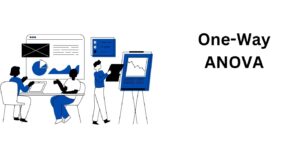In hypothesis testing, a critical value is a threshold or cutoff point that defines the boundary of the rejection region…
What is a One-Way ANOVA: A Comprehensive Guide
A One-way ANOVA, also called a one-way analysis of variance is a statistical method mainly used to test whether there are significant differences in means when there are 3 or more groups. In other words, it is an extension of the independent sample t test, when the independent groups are more than 2.
In this article, we present a detailed discussion of the one-way ANOVA, when to use it, one-way anova assumptions, examples and a step-by-step process of calculating a one-way ANOVA by hand.
However, if you are familiar with the one-way ANOVA and wishes to know how to perform the test in spss, check out the guide on how to perform ANOVA test in SPSS.
When to Use a One-Way ANOVA

A one way ANOVA is used to determine whether there are any statistically significant differences between the means of three or more independent (unrelated) groups. It is widely used in various fields including science, psychology, biology, nursing, business, and economics, when there is a need to compared group means. A one-way analysis of variance is an important statistical test because it help in comparing the means of three or more groups and determining whether there is a significant mean different between any two groups.
However, it is worth noting that a one-way analysis of variance will only inform you whether there is a significant mean difference between any two groups. In other words, it does not indicates the specific groups with significantly different means. When it is established that there is a significant mean difference between any two groups, Post hoc analysis test comes in handy. Post hoc analysis test serves as a follow up test to identify the specific groups that significantly differ in the means.
Hypothesis Testing in One-Way ANOVA
As highlighted above, a one-way analysis of variance compares the means between3 or more unrelated groups. It aims to determines whether any of those group means are significantly different from each other. Specifically, the null and alternative hypotheses in one-way Analysis of variance are:
H0: The means in all the groups are equal (Not significantly different)
H1: At least two means are significantly different.
Therefore, if the one-way ANOVA reject the null hypothesis at a pre-defined significance level, we conclude that there is a significant mean difference between any two groups.
At this point, it is important to realize that the one-way Analysis of variance is an omnibus test statistic and cannot tell you which specific groups were statistically significantly different from each other, only that at least two groups were. To determine which specific groups differed from each other, you need to use a post hoc test.
One-Way ANOVA Assumptions
In practice, checking for these six assumptions just adds a little bit more time to your analysis, requiring you to click a few more buttons in SPSS Statistics when performing your analysis, as well as think a little bit more about your data, but it is not a difficult task.
Before we introduce you to these six assumptions, do not be surprised if, when analyzing your own data using SPSS Statistics, one or more of these assumptions is violated (i.e., is not met). This is not uncommon when working with real-world data rather than textbook examples, which often only show you how to carry out a one-way Analysis of variance when everything goes well! However, don’t worry.
Even when your data fails certain assumptions, there is often a solution to overcome this. First, let’s take a look at these six assumptions: [continue with the rest of the text].
First, let’s take a look at these six assumptions:
- Normality: The data should be normally distributed.
- Independence: The observations should be independent of each other.
- Homogeneity of variance: The variances of the groups being compared should be equal.
- Linearity: There should be a linear relationship between the dependent and independent variables.
- Absence of multicollinearity: The independent variables should not be highly correlated with each other.
- Absence of outliers: There should be no extreme values that significantly affect the results.
Checking for these assumptions may require additional steps and analysis in SPSS Statistics. Violations of these assumptions are not uncommon, especially when working with real-world data. However, there are strategies to address the violations and still obtain meaningful results.
How to Calculate One-Way ANOVA By Hand
To conduct a one-way analysis of variance by hand, you need to calculate Within-groups sum of squares (SSW) and Between-groups sum of squares (SSB).
Next, calculate the mean sum of squares within-groups (MSW) by dividing the within-groups sum of squares by the corresponding degrees of freedom (n-k).
Next, calculate the mean sum of squares between-groups (MSB) by dividing the between-groups sum of squares (SSB) by the corresponding degrees of freedom (k-1).
Where, n is the total sample size and k is the number of independent groups being compared.
Once, you have computed both MSW and MSB, then the test statistic is given by;
F = MSB/MSW
In this formula,
- F is the test statistic
- MSB = Mean sum of squares between the groups
- MSW = Mean sum of squares within groups
To make decision and conclusion about the one-way Analysis of variance hypothesis, you compare the computed test statistic (F) with the critical value (Fα, k-1, n-k).
If the test statistic (F) is greater than the critical value, (Fα, k-1, n-k), we reject the null hypothesis. Otherwise do not reject the null hypothesis.
If the null hypothesis is rejected, then we say that “there is sufficient evidence to conclude that there is a significant mean difference between any two groups” After making this decision, you need to perform post hoc test to determine which among the independent groups are statistically significantly different.
If you are familiar with running one-way Analysis of variance test in SPSS and need help on how to report the one-way ANOVA results, check out this article. Reporting One-Way ANOVA results in APA.







